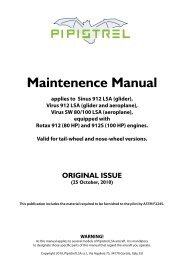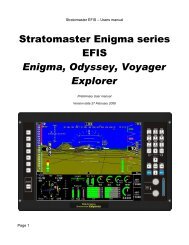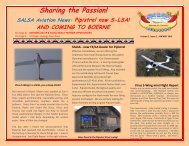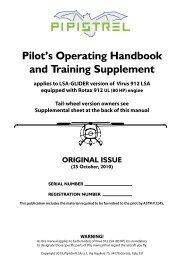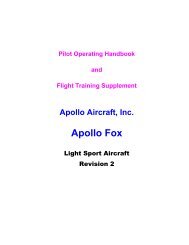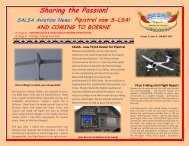Pipistrel Virus Aircraft Operating Instruction - Salsa Aviation
Pipistrel Virus Aircraft Operating Instruction - Salsa Aviation
Pipistrel Virus Aircraft Operating Instruction - Salsa Aviation
You also want an ePaper? Increase the reach of your titles
YUMPU automatically turns print PDFs into web optimized ePapers that Google loves.
AIRCRAFT OPERATING INSTRUCTIONS – VIRUS 912 S-LSA GLIDERCAUTION! It is not recommended to fly the aircraft at speeds exceeding 80 kts (150 km/h) usingflap setting other than negative.CAUTION! Check fuel upon establishment of cruise attitude. Because of the fuel system design,the fuel tends to gradually cross-flow from the right tank to the left. To prevent this, shut theright fuel valve and open it again when the fuel level inside left tank has lowered.CAUTION! If the fuel quantity in a fuel tank is low, it is possible that the engine starts to suck airinto the fuel system. To prevent this and consequent engine failure, always close the fuel valve ofthe tank where the fuel quantity is very low.Cruising in rough conditions. Should you experience turbulence, reduce airspeed to V A , 76 kts,and continue flying with flaps set to neutral position.CAUTION! In rough air, reduce engine power if necessary to keep airspeed below V A .Descent and final approachDescend at speeds at or below V A and flaps in negative stage. To expedite descents, useairbrakes (if applicable) and keep airspeed below VAE. For approach, reduce speed to 70 kts (130km/h) and set flaps to 1st position only after turning to base leg. Adjust engine power tomaintain proper airspeed. Set trim to neutralize stick force if necessary. During the descentmonitor temperatures and keep within operational limits.CAUTION! During the descent, engine power MUST be reduced. Should you be forced todescend at idle power, make sure you keep adding throttle for short periods of time, this willhelp to keep spark plugs clean.CAUTION! With flaps in 2nd position, no more than half of the available aileron deflection ispermitted.On final, set flaps to 2nd position. Align with the runway and reduce power to idle. Extendairbrakes (as required) and maintain an airspeed of 55 kts (102 km/h). Instead of throttle useairbrakes to control your descent glide path. Otherwise, control your attitude and crab or slip asnecessary.CAUTION! Crosswind landings require higher final approach speeds to ensure aircraft’s safemaneuverability. Increase the approach speed by 1 kts for every 1 kts of crosswind componente.g. in case of 5 kts crosswind component, increase the approach speed by 5 kts.Roundout and touchdownCAUTION! See chapter “Performance” for landing performance.Roundout and touchdown (flare) occurs at following airspeeds:CAUTION! Land the aircraft in such a manner that the two main wheels touch the ground first,allow the nose-wheel touchdown only after speed has been reduced below 25 kts. Whenlowering the nose wheel to the runway, rudder MUST NOT be deflected in any direction (rudderpedals centered).Page 30



